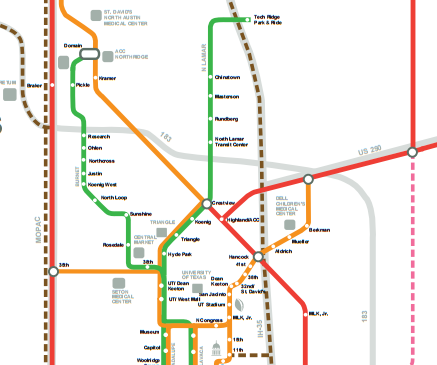Website hack shines light on Project Connect
Friday, May 15, 2015 by
Caleb Pritchard Project Connect, the grand vision for high-capacity transit in Central Texas, has spent a good chunk of 2015 completely out of sight. However, a top Capital Metropolitan Transit Authority official assured the Austin Monitor on Thursday that it’s just temporarily lying fallow after its roads-and-rail bond referendum went off the tracks in November.
Todd Hemingson, Capital Metro’s vice president of Strategic Planning and Development, said that voters’ overwhelming rejection of Proposition 1 was a blow to the coalition that comprises his agency, the City of Austin, the Capital Area Metropolitan Planning Organization and Lone Star Rail. However, he said, Project Connect is still a concern.
“While (Prop 1) didn’t pass, system planning with Project Connect is still alive, and it is still the guiding light for planning within the region,” Hemingson said, describing its current state as simply “a lull, in terms of funding.”
It has also been a lull in terms of public communication. Project Connect’s once-busy Twitter and Facebook accounts have not uttered a peep since Jan. 23, and both still feature links to a website that was defaced by self-proclaimed Algerian hackers earlier this month. KUT’s Terrence Henry publicly noted that hack on May 1, and officials quickly took down the main page. However, other pages on the website featuring the hackers’ handiwork remained visible to the public until late Thursday morning, after the Monitor brought it to the attention of both Hemingson and officials at the Austin Transportation Department.
As for going after the hackers, Capital Metro’s Francine Pares said, “After we learned of the intrusion, we got in contact with the Secret Service. We’ve given them all the information we have, so it’s all in their hands.”
(Incidentally, the hackers, who identified themselves as Moh Ooasic and Lakhdar DZ, seem to have targeted Project Connect at random. According to a site that tracks Internet vandalism, Moh Ooasic is responsible for more than 2,900 similar hacks since mid-March. Digital security expert and former hacker Gregg Housh told the Monitor that the cyber vandals’ technique is “in no way sophisticated” and “not the style of anything or anyone organized.”)
In the meantime, Hemingson said Capital Metro’s commitment to Project Connect would continue, albeit in slightly altered fashion — specifically, one that will put extra emphasis on connecting communities outside of the transit agency’s jurisdiction. The CAMPO 2040 plan approved last week includes four Project Connect corridor studies as “action items” that will “shape our transportation future.”
One of those corridor studies, East Riverside Drive from I-35 to SH-71, is already completed. The three others are the Northwest Corridor from Austin to Liberty Hill, the Southwest Corridor from Austin to San Marcos and the East Corridor from Austin to Manor. Not listed as an action item in the CAMPO 2040 plan is the North Corridor Study, which will likely be considered by the City of Georgetown sometime this summer.
“Most of these projects are contingent on jurisdictions beyond CapMetro’s service area,” Hemingson said. “At the end of the day, that corridor plan won’t move forward unless they decide to participate.” He said the Project Connect vision along these corridors includes buses using brand-new tolled express lanes on existing highways.
As for the fate of the Central Corridor, the prospective home of the urban rail project that became Project Connect’s Leipzig if not its Waterloo, Hemingson explained that plans are in a holding pattern thanks in part to Mayor Steve Adler. Hemingson said Adler personally brought concerns that he had heard from constituents on the campaign trail to Capital Metro officials, saying that many voters he had talked to did not sense a benefit for themselves in the doomed urban rail plan.
“We could have done a better job explaining that it was part of an overall system plan,” Hemingson said.
Hemingson also revealed that Capital Metro is preparing a federal TIGER grant application in order to request federal money for new stops along the two 801 and 803 MetroRapid routes. It would place those stops along the existing routes at new, densely developed areas currently bypassed by the service.
He explained that the agency could not simply use existing local stops for the express MetroRapid buses because “one of the key things for best practices in BRT (bus-rapid transit) is strong branding and system identification. The concern is, if you start stopping at local stops without that branded station, you kind of water it down.”
According to a score card developed by the Institute for Transportation and Development Policy to grade BRT services, “branding” is worth 3 out of a possible 100 points. The ITDP did not include MetroRapid in its annual survey of international BRT systems, but in 2013, a local transit advocate gave Capital Metro’s new premium-fare service a total score of 36 points.
As each of the various parts of Project Connect continue to move forward, Hemingson said that public outreach will also resume. That process, he noted, begins with relaunching its wounded website.
“We need to get that updated,” Hemingson said. “If we’re going to tell the community that Project Connect is still alive, then we need to have the information available that supports that.”
Image courtesy of the Capital Area Metropolitan Planning Organization.
You're a community leader
And we’re honored you look to us for serious, in-depth news. You know a strong community needs local and dedicated watchdog reporting. We’re here for you and that won’t change. Now will you take the powerful next step and support our nonprofit news organization?






